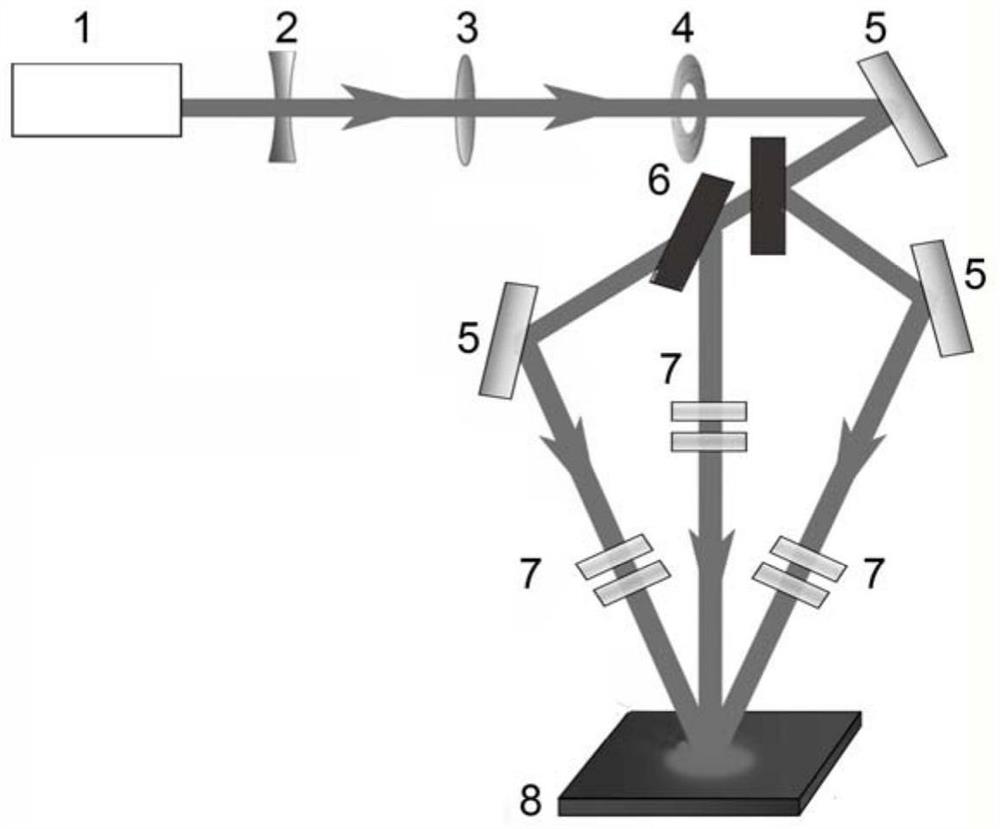A method for preparing patterned ordered bimetallic nanoparticle array by annealing method
A bimetallic nano-patterning technology, which is applied in semiconductor/solid-state device manufacturing, electrical components, circuits, etc., can solve problems such as the inability to achieve high-density patterned nano-particle distribution, the inability to be widely used, and the inability to make the distance small. Achieve the effect of controllable pattern, high stability and controllable particle size
- Summary
- Abstract
- Description
- Claims
- Application Information
AI Technical Summary
Problems solved by technology
Method used
Image
Examples
Embodiment 1
[0033] like figure 1 As shown, the present invention adopts the annealing method to prepare the method for periodically patterned bimetallic nanoparticles as follows:
[0034] (1) Prepare a patterned substrate by laser interference: build a laser interference system according to the expected pattern (5μm side length hexagonal array), select a 1064nm Nd:YAG nanosecond laser (pulse width is 6ns, repetition rate is 10Hz), and the light splits The system generates three coherent beams and adjusts the energy density of the interference laser to 400mJ / cm 2 , the interference light acts vertically on the surface of the single-sided polished (100) oriented single-crystal silicon wafer for 5 seconds, and ablates a hexagonal array pattern with a side length of 5 μm.
[0035] figure 2 It is a three-beam laser interference ablation system, including a 1064nm nanosecond laser 1, a concave lens 2, a convex lens 3, a variable aperture 4, a mirror 5, a beam splitter 6, a half-wave plate an...
Embodiment 2
[0042] In Example 2, the energy density of the interference laser was adjusted to 350mJ / cm 2 , other experimental parameters are consistent with Example 1, and the results are as follows Figure 7 shown.
[0043] The silicon substrate after laser interference ablation was tested by scanning electron microscope SEM, and the results were as follows Figure 7 shown in a. Since the intensity of the interference laser has a periodic Gaussian distribution, when it acts on the surface of the silicon material, the silicon surface is ablated, melted, evaporated, and solidified with high energy, and has a nanostructure distribution. In this embodiment, the size of the nanostructure is about 10 nm. Under the action of low energy, the silicon surface did not reach the melting threshold and did not change, forming a microstructure pattern consistent with the laser interference pattern, with a micrometer scale of 5 μm. Microstructure patterns and nanostructures form periodic cross-scale ...
Embodiment 3
[0046] In Example 3, the energy density of the interference laser was adjusted to 500 mJ / cm 2 , other experimental parameters are consistent with Example 1, and the results are as follows Figure 8 shown.
[0047] The silicon substrate after laser interference ablation was tested by scanning electron microscope SEM, and the results were as follows Figure 8 shown in a. Since the intensity of the interference laser has a periodic Gaussian distribution, when it acts on the surface of the silicon material, the silicon surface is ablated, melted, evaporated, and solidified with a nanostructure distribution. In this embodiment, the nanostructure size is about 30 nm. Under the action of low energy, the silicon surface did not reach the melting threshold and did not change, forming a microstructure pattern consistent with the laser interference pattern, with a micrometer scale of 5 μm. Microstructure patterns and nanostructures form periodic cross-scale micro / nanostructure pattern...
PUM
| Property | Measurement | Unit |
|---|---|---|
| thickness | aaaaa | aaaaa |
| wavelength | aaaaa | aaaaa |
| thickness | aaaaa | aaaaa |
Abstract
Description
Claims
Application Information
 Login to View More
Login to View More - R&D
- Intellectual Property
- Life Sciences
- Materials
- Tech Scout
- Unparalleled Data Quality
- Higher Quality Content
- 60% Fewer Hallucinations
Browse by: Latest US Patents, China's latest patents, Technical Efficacy Thesaurus, Application Domain, Technology Topic, Popular Technical Reports.
© 2025 PatSnap. All rights reserved.Legal|Privacy policy|Modern Slavery Act Transparency Statement|Sitemap|About US| Contact US: help@patsnap.com



